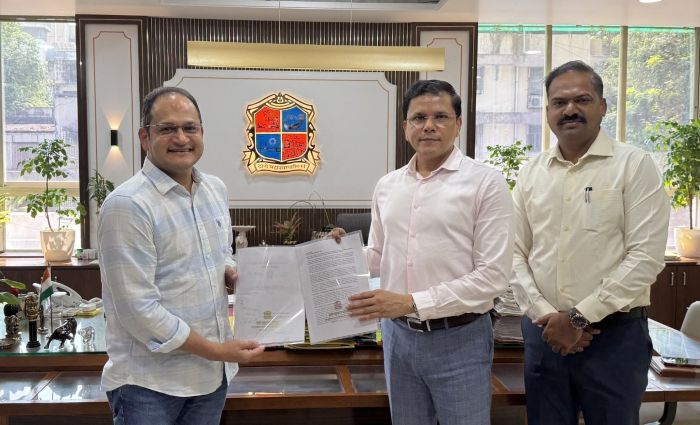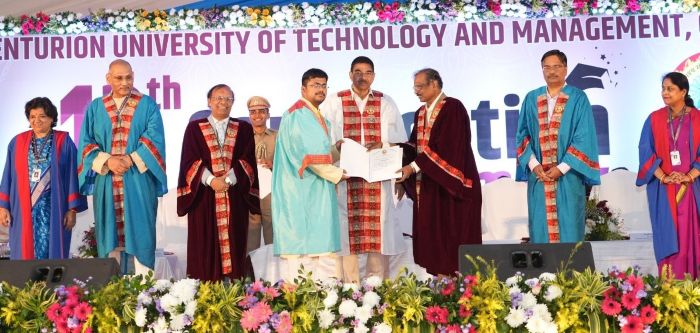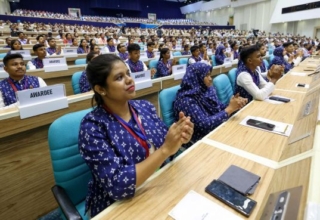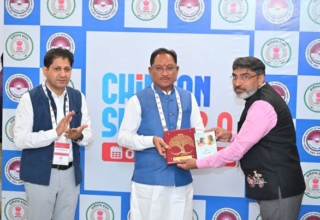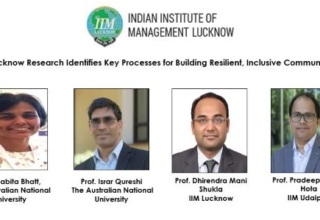
On August 14, the Lok Sabha passed the Apprentices (Amendment) Bill 2014, a landmark legislative labor reform, which could potentially shake up the entire skill development architecture in the country after it becomes a law (the Rajya Sabha has yet to pass it)
THE MUCH DESIRED amendments to the 53-year-old archaic Apprentice Act, 1961 have crossed the first hurdle as the Lok Sabha on August 14 passed the Apprentices (Amendment) Bill 2014. The amended Apprentice Act (if and when passed by the Rajya Sabha) will have a dramatic effect on the skill development landscape once it comes in force expectedly, sometime later this year. The current number of apprenticeships will see a five-fold increase and the overall number could rise manifold as several non-technical trades hitherto not included in the Act will become its part. India has 4,80,000 seats available for apprenticeship and against this, only 2,80,000 people are imparted skills. By contrast, Germany has 3 million, Japan 10 million and China has 20 million apprentices who pick up critical employment skills through a hands-on approach. Replying to a debate on the Bill, labour minister Narendra Singh Tomar said this “revolutionary” step will help the country meet the growing requirement of skilled people whose number could rise to 2.4 million from the current level of 4,29,000. The outdated and rigid procedures of the Apprentice Act, 1961 with provision of punitive action has made it less attractive for employers and provided a perfect breeding ground for wide-spread corruption in industrial relations and government enforcement field staff. With creation of jobs propelled by skill development becoming the most important national priority given the scale at which these would be needed to fulfill aspirations of a country with two-thirds of youth population, serious efforts in this direction going on for a while have got a fillip after the new NDA government under the Prime Ministership of Narendra Modi took over. His “skills, scale and speed” formula and ‘skilled India’ vision have really infused the much needed hope and enthusiasm. According to observers the amended Apprentice Act, which provides for apprenticeships in the ratio of 10% of the total worker of all trades, will be the real game changer. “Since 2009, after the National Skill Development Policy was promulgated, what followed in the name of skill development is a piecemeal approach at best and in fact a mirage. In the name of skilling, people just provide theoretical training, which can well be imparted easily in schools and colleges. For competency-based training, you need actual hands on experience much like a medical degree, where working in hospital is a must. If the new apprentice law is sincerely enforced and industries embrace it, India can easily catch up in manufacturing globally,” said one expert on condition of anonymity. It may be mentioned that 90% of skills training in the country is funded by government at present. And most employers identify unemployability as a big challenge! The Apprentices Act, 1961 was enacted with the objective of regulating the programme of training of apprentices in the industry by utilizing the facilities available therein for imparting on-the-job training. The Act makes it obligatory for employers to engage apprentices in designated trades to impart apprenticeship training on the job in industry to school leavers and person having National Trade Certificate (ITI pass outs ) issued by National Council for Vocational Training (NCVT), Graduates engineer, Diploma holder and Certificate in 10+2 vocational stream to develop skilled manpower. There are four categories of apprentices namely; Trade Apprentices (ITI pass outs, 8th , 10& 12pass outs), Graduates engineer apprentices, Technician apprentices (Diploma level) and Technician (Vocational) apprentices (Certificate in 10+2 vocational courses). The amendment process was kick-started May this year after an inter-ministerial group (IMG) comprising representative from Ministry of Railways, Ministry of Micro Small Medium Enterprises, Ministry of Power, Ministry of Defence, Planning Commission, National Skill Development Agency (NSDA) & DGE&T met for discussion on the recommendations proposed by PM’s NCSD, CAC , NCL, ILC, CII and NSDA and WG as a first step. Three meetings of the IMG were held. In all 17 issues were identified for amendment. The group noted , “Comparing the size and rate of growth of economy of India, the performance of Apprenticeship Training Scheme (ATS) is dismal and a large number of training facilities available in the industry going waste depriving unemployed youth to avail the benefits of the ATS. To improve the participation of industry and youth in ATS in a large number, Office of the Prime Minister’s National Council on Skill Development (PM’s NCSD), Central Apprenticeship Council (CAC) , National Commission on Labour (NCL), Indian Labour Conference (ILC), Confederation of Indian Industry (CII) and National Skill Development Agency (NSDA) have given a slew of recommendations to make changes in the Apprentices Act, 1961 to make it more responsive to industry and youth. Apart from above, a Working Group constituted by DGE&T, Ministry of Labour & Employment for revamping all the Schemes run by DGE&T has also given its recommendations in respect of Apprentices Act.” The IMG considered and recommended that within a financial year each establishment should not engage apprentices less than 2.5% and not more than 10% of the total worker of all trades. As per the existing process, addition of a trade/occupation starts with preparation of course curriculum by trade experts followed by approval of CAC & NCVT members, vetting of notification and its publication in the Gazette of India. The entire process is time consuming. The IMG considered and recommended that companies may be allowed to starts new trade without waiting for notifying such trades in the official gazette of India. But it may be obligatory for the establishment to disclose the duration and syllabi of the Optional Trades on the web-portal to check the quality of training. The amendments have incorporated IMG’s recommendation that the scope of the apprenticeship training should be enhanced in order to bring the internship/on-the-job training of other courses, all graduates in various fields such as B.A, B.Com., B.Sc., etc. may be brought under Act to enhance their skills and employability. The IMG had also recommended that in order to include modules under SDI and other courses run by SDCs of States, approved by NSDA, provision of rebate in the apprenticeship training period should be allowed for the persons undergone such training while preparing course curricula under ATS. Accordingly, Section 2(j) & Section 6 have been amended. The rates of stipend should be 70% to 90% of the minimum wages for semi skilled workers applicable in the States/UTs from Year1 to Year3 respectively. The IMG also recommended that in case of establishments which are having turnover less than Rs. 100 crore and are covered under the Micro, Small and Medium Enterprise Development (MSMED) Act, stipend will be shared by the Government equally during the first year of the training only . This support may be initially given only for apprentices in designated trades but may be considered subsequently for optional trades also keeping in view the response of the scheme and the financial implications. Accordingly, rule 11 of the Apprenticeship is amended With the existing provision relating to qualification and age requirement made in the Act is for designated trade, the employers particularly in informal sector find it difficult to engage apprentices. Further it may not be feasible to bring employers/ establishment in the informal sectors under the ambit of apprenticeship training scheme. The IMG considered the above and recommended that in case of apprenticeship training in informal sector (optional trade), the qualification, physical fitness etc. may be decided by the employer, subject to minimum age as per law of the land. But the age should not be less than 18 years in trades related to hazardous industries for both optional and designated trades. Due to fear of imprisonment, employers tend to avoid coming under the purview of the Act and training facilities available with them go unutilized. Now the imprisonment clause has been dropped and under the amended Act t those establishments which are not engaging full quota of apprentices and having more than 250 workers will invite penalty at the rate of Rs. 500 per shortfall of Apprenticeship Month. Establishment or industry which is under the Board of Industrial and Financial Reconstruction and any establishment or industry having less than two hundred and fifty workers shall not be liable for such penalty. Non-payment of penalties in time may be allowed with 10% interest and unpaid penalties may be made recoverable as arrear of land revenue. To begin with, all the MSMEs may be required to engage apprentices as per their obligation and requirement and if need is arisen, MSMEs may identify competent training providers themselves for providing basic training to their apprentices. Holidays, leaves, shift working and hours which in the present Act have been prescribed separately for apprentices have been made comparable with regular workers except coverage in ESI Act which is separate dispensation for regular workers. According to Skill Development expert, Navin Bhatia , the government must ensure implementation of New apprenticeship act. He proposes a model whereby employers appoint supervisors as Ustaads(Trainer cum Assessor) to deliver world class on the job training. “Revive Ustaad skill development tradition. Set goal of 15 lakh apprentice a year with 1 lakh Ustaads across sectors(gharanas). A very detailed Blue Book for Assessors or Ustaad should be created for each sector which articulates in detail how to assess skills of the apprentice on the job.” While the amendment has brought much needed hope to real-time, real world skilling solutions, another big stride that the government may take is to make the newly created Union ministry of skill development and entrepreneurship (SDE), a super skills ministry. There are reports that Narendra Modi-led NDA government at the centre is all set to shift various skill development initiatives currently administered under 21 central ministries and departments to the newly constituted ministry of skill development & entrepreneurship any time soon, though there is no official confirmation of the move as of now. Union budget 2014 has cumulatively allocated Rs 25,000 cr for these various skill development initiatives and once these come under one ministry, the funds will be also transferred to it. According to media reports the Director-General of Employment and Training (DGET), an attached office of the union labour & employment ministry that oversees industrial training institutes, apprenticeships and other vocational training programmes, could be shifted entirely to the skill development ministry. NSDC under the finance ministry and skill development and entrepreneurship agencies with the ministry of micro, small and medium enterprises (MSME) are expected to be merged with the new ministry. Similarly, the technical education wing of human resource development ministry, the National Rural Livelihoods Mission, and Ajeevika programmes under the rural development ministry would be brought under the ministry’s purview. It is pertinent to mention that since 2009, when the National Skill Development Policy was formulated, individual ministries had been thwarting any attempts to harmonize and integrate skill development landscape in the country. The move may be also accompanied by amendments in the existing apprenticeship act later this year during the winter session of the parliament. Currently, only 10 per cent of the workers between the ages of 15 and 59 years in the country have some amount of professional training in India, of which just an abysmal 2.5 per cent have professional training. Every year 12 million youth are joining the workforce, majority of them lack skills. There is a target of skilling 500 million people by 2022, the year India will be celebrating 75th year of independence. There are also indicators that National Employability Through Apprenticeship Program (NETAP), a public private partnership or PPP project proposed by the National Skills Development Corporation (NSDC), Teamlease Skills University (which is itself a PPP with the Gujarat government) and the Confederation of Indian Industry or CII could be scaled up under the supervision of MHRD. While welcoming any move that provides focus on the real delivery, Skills development commentator and MD of Navkar Skills Centre, New Delhi, Navin Bhatia says there are vague linkages between growth-Job creation and Skill development. We need an implementation framework, which hopefully the new ministry can provide. “Creating capability of skill ecosystem on NOS, content, skill trainers, assessors &certifying bodies across sectors across districts of India must be prioritized. Unless we have focus on manufacturing skills across existing 4000 clusters & new 100 cities/industrial township and massive scale up of delivery skill at schools from IX to XII standards,” he adds. Meanwhile a report on skills assessment in India by the UK-based The Research Base and released by ILO & British Council in New Delhi on July 24 says by 2019 India will be needing five-times the number of assessors as has currently, an estimated 10,000. According to the report the key challenges in the area for India are multitude of systems and processes, balance between urgent demand and need for high quality assessment, capacity to interpret NOS (National Occupational Standards) and quality parameters, delay between training and assessment and lack of assessor training. Paul Comyn, Officer-in-Charge, ILO Decent Work Team for South Asia and Country Office for India, says “The introduction of competency based training as part of the National Skills Development Policy poses real challenges for the skills system in India. If the push for 3rd party assessment continues, significant investments in assessor training and quality assurance of assessment will be required to ensure the integrity of national qualifications.” The report recommends third party skill assessment in light of international best practices. According to J P Rai, director general, National Skills Development Authority (NSDA), currently there are five pilots on skill assessment underway under various sector skill councils and once reports emerge from them, then only can various administering parameters including cost be arrived. Skills training is as of now predominantly a government funded activity in India and as such government will have to take a considered view before allowing anything that will offer international equivalence and mobility. “Skills imparting is at an evolving stage and currently caters to mostly school/college dropouts. We have to encourage them and not create a barrier in the name of assessment, but we need an assessment system, “says Gayathri Kalia, chief operating officer, Ajeevika Skill Development Program of the ministry of rural development. Clearly the (missing) content, assessors and assessing bodies will be the most formidable challenge before the new skilld development governance system. Lot will depend on the vision and working style of Sarbananda Sonowal, the MoS who has independent charge of the new ministry besides youth affairs and sports, how will he seize the opportunity of skilling youth and importantly deliver on implementation processes. Watch out!


